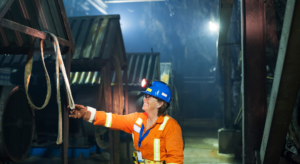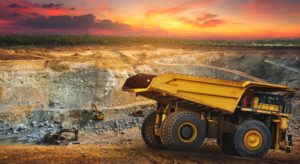The mining industry is revolutionized with the inclusion of microscopic sensor networks, often referred to as “Smart Dust.” These minuscule devices, no larger than a grain of sand, are redefining how mining operations monitor, analyze, and optimize their processes. With MEMS technology combined with wireless communication capabilities, Smart dust in mining establishes an invisible but powerful web of sensors in operations. This new technology promises to produce advanced safety, efficiency, and real-time decision-making capabilities in ways considered impossible.
As mining companies are embracing the digital revolution, smart dust is a big step toward truly intelligent and connected mining operations. The article looks at applications of Smart dust in mining across safety and risk management, operational efficiency, and environmental impact management for how such microscopic sensors can revolutionize the mining industry.
Smart Dust In Mining: Safety and Risk Management
Smart dust technology, in its application, has fully changed the way mining activities approach safety and risk management. This has given an unprecedented amount of environmental awareness and hazardous detection. So, let us dive deeper into the technology’s elements that ensure safety and risk management:
Real-time Gas Detection and Air Quality Monitoring
Smart dust sensors are sparsely distributed across all mining tunnels and open-pit areas. Thus, it helps to monitor atmospheric conditions in real time. Furthermore, using micro-sensors, there is a possibility of detecting fatal gases such as methane, carbon monoxide, and hydrogen sulfide with incredibly high accuracy. Moreover, the dynamic map of air conditions is established through sensor networks. This aids mining operations to indicate risks before they become critical. It also helps to respond rapidly to changing conditions that can prevent accidents associated with poor air quality or dangerous gas buildup.
Structural Integrity Monitoring
Smart dust sensors are spread throughout mining structures, supports, and rock faces. These sensors record slight pressure, vibration, and displacement changes continuously. Furthermore, the sensors can identify early warning signs for possible structural weaknesses or cave-in occurrences. So, the data recorded becomes highly crucial in avoiding collapses. Moreover, the technology helps mining engineers monitor and look out for stability in real-time of underground tunnels and open-pit walls. This way, proactive maintenance, and reinforcement measures can also be taken before there are critical failures.
Emergency Response and Evacuation
Smart dust networks offer full emergency response systems. This is by monitoring the environmental conditions along with the locations of the workers simultaneously. Furthermore, in emergencies, these sensors provide real-time data. This is about safe evacuation routes, tracking worker movements, and identifying areas of immediate danger. The system can also automatically trigger alerts and guide workers to safety through the fastest and safest available paths. As a result, it can greatly improve emergency response times and effectiveness.
Personnel Safety Tracking
Smart dust in mining, in combination with personal protective equipment, tracks the location and vital signs of workers precisely. Furthermore, these small sensors can track the heart rate, body temperature, or exposure to harmful substances and give accurate position data. Moreover, comprehensive monitoring like this helps to prevent accidents due to fatigue, overexertion, or hazardous conditions. It also enables prompt location and rescue when accidents happen.
Microscopic Sensors in Mining: Operational Efficiency
Smart dust technology has improved mining operations in terms of the availability of levels of data granularity and real-time monitoring capacity. This, in turn, has shown tremendous improvements in productivity as well as the usage of available resources. So, let us see how microscopic sensors provide operational efficiency in-depth:
Equipment Performance Optimization
Smart dust sensors installed on mining equipment continuously feed information on mechanical performance, temperature, vibration, and wear patterns. This detailed information helps in formulating predictive maintenance schedules. This is where the equipment does not stop without warning, and the product lifecycle is optimized. Moreover, the system can detect failure precursors. So, it allows maintenance teams to get to problems before they become issues that will result in some expensive downtime or repair.
Resource Tracking and Management
Microscopic sensors implanted in material handling systems monitor the movement of ore from extraction to processing with extraordinary precision. Furthermore, these sensors track material quality, quantity, and flow rates in real-time. It helps to optimize resource allocation and minimize waste. Moreover, this technology helps the mining operations maintain accurate inventory levels. This is while identifying bottlenecks and inefficiencies in the production process.
Energy Consumption Analysis
The smart dust network monitors everything, from tiny pieces of equipment to total processing plants. Furthermore, the energy consumption patterns unveiled by such sensors are capable of revealing the areas where work could be optimized and, subsequently, savings may be in order. It also enables the mining company to offer efficient energy management strategies. This is while reducing its footprint in the environment through better use of resources.
Process Automation Integration
The integration of Smart dust in mining with automated mining systems creates a seamless network of sensors and controls. Furthermore, this integration enables real-time adjustments to mining processes. It is based on environmental conditions, equipment performance, and production requirements. Moreover, implementing smart dust sensors for real-time mining operations analysis helps in making the process autonomous. This is where systems can self-adjust to maintain optimal performance levels.
Smart Dust In Mining: Environmental Impact Management
Smart dust technology has enabled mining operations to reduce their footprint on the environment while still fully complying with increasingly stringent regulations. So, let us see how smart dust in mining ensures accurate management of the impact on the environment:
Water Quality Monitoring
Smart dust sensors dispersed throughout water management systems provide constant monitoring of pH levels, contamination, and pattern of usage of water. Furthermore, the sensors enable a mining operation to identify as well as react to all conceivable contamination events in a timely fashion. This is while optimizing the processes for using as well as treating water. Moreover, the technology helps ensure conformity to the environmental laws while protecting the local water resources from mining impacts.
Dust and Emissions Control
Air quality, dust levels, and emissions are monitored in real time by microscopic sensors distributed across mining sites. Furthermore, this network allows for the precise control of dust suppression systems and helps identify sources of excessive emissions. The technology also allows mining operations to maintain air quality standards. This is while reducing the environmental impact on surrounding communities.
Biodiversity Impact Assessment
Smart dust in mining placed in and around the surrounding ecosystems provides data regarding wildlife movement, vegetation health, and habitat conditions. This information proves useful in providing data needed for more effective environmental management strategies for mining operations regarding biodiversity. Moreover, this technology promotes the balance between productive operational needs and the conservation needs of the environment.
Rehabilitation Progress Tracking
Networks of smart dust in mining monitor soil conditions, vegetation growth, and ecosystem recovery in rehabilitated mining areas. Furthermore, detailed data from these sensors outline the success of rehabilitation activities and pinpoint areas that may need further attention. In this way, mining companies can ensure the effectiveness of their environmental restoration projects, while remaining compliant with the requirements for closure.
To Sum Up
Smart dust technology shows a major change in mining operations. It provides unprecedented sensing, measurement, and control. Furthermore, as mining evolves, these microscopic sensors will become ever more important in crafting safer, more efficient, and environmentally sound operations. Additionally, the combination of smart dust in mining with other new technologies is likely to release even more of the optimization and innovation potential in the mining industry.
Excellent opportunities are in store for the mining professionals who want to catch up on the latest innovations in mining technology with the 6th Mining 4.0 Summit, on 6-7 November 2024 in Barcelona, Spain packed with sessions by experts, case studies, and panel discussions on the latest technologies, trends, challenges, practical strategies, and more. It will also give fantastic opportunities for networking to stay a step ahead of competitors. Register now!





